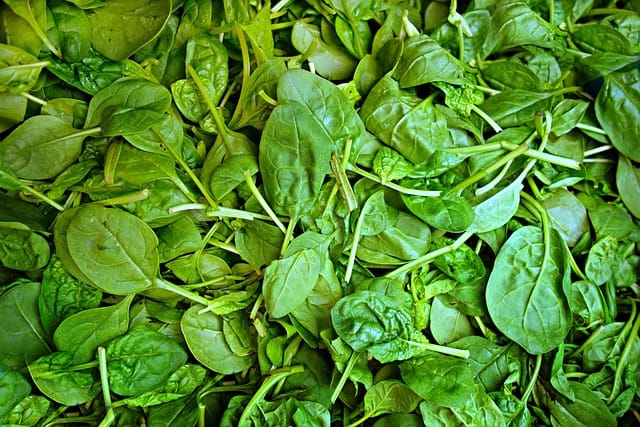Spinach, those dark, leafy greens, might not make you instantly strong like Popeye, but they’re definitely a nutritional powerhouse packed with vitamins, minerals, and antioxidants. Growing spinach is like having your own superfood factory in the backyard, and it’s easier than you might think!
Imagine stepping into your garden and harvesting a handful of fresh spinach leaves, their deep green color signaling their incredible health benefits. From salads to smoothies, soups to stir-fries, spinach is a versatile veggie that can be enjoyed in countless ways. Plus, growing your own means you can enjoy it at its peak freshness, when its flavor and nutrients are at their best.

Why Grow Spinach?
- Health boost: Spinach is a nutritional superstar, loaded with vitamins A, C, and K, as well as iron and folate.
- Garden variety: There are many different types of spinach, from savoy with its crinkled leaves to smooth-leaf spinach with its tender texture.
- Easy to grow: Spinach is a relatively low-maintenance crop that can thrive in a variety of conditions. Spinach is one of the 13 best easy-to-grow garden vegetables.
- Cut-and-come-again: You can harvest spinach leaves multiple times from the same plant, extending your enjoyment.
- Cool-season champ: Spinach loves cooler temperatures, making it a great choice for spring and fall gardens.
How to Eat Spinach:
- Salads: Enjoy raw spinach leaves in salads for a nutritious and flavorful base.
- Smoothies: Add spinach to smoothies for a boost of vitamins and minerals.
- Soups: Spinach adds flavor and texture to soups and stews.
- Side dishes: Sauté spinach with garlic and olive oil for a simple yet satisfying side dish.
- Pasta dishes: Incorporate spinach into pasta dishes like lasagna or ravioli.
Growing Spinach:
Spinach is a cool-season annual that prefers cooler temperatures.
- Sow seeds directly into the ground in early spring or late summer.
- Choose a sunny location with well-drained soil.
- Space seeds about 1 inch apart and thin seedlings to 4-6 inches apart as they grow.
Watering:
- Water regularly, especially during dry periods, to keep the soil consistently moist.
Fertilizing:
- Spinach is a moderate feeder, so fertilize it regularly with a balanced fertilizer.
Light Requirements:
- Spinach needs at least 4 hours of sunlight per day, but it can also tolerate some shade.
Harvesting:
- Harvest spinach leaves when they are about 4-6 inches long.
- You can harvest individual leaves or cut the entire plant at the base.
Tips and Tricks:
- Mulch around the plants to help retain moisture and suppress weeds.
- Rotate your spinach crops each year to prevent diseases.
- Protect your plants from pests like slugs and aphids by using organic pest control methods.
- For a continuous harvest, plant spinach in succession every few weeks.
Spinach Cuisine:
Spinach is incredibly versatile in the kitchen. Here’s a simple recipe to get you started:
Sautéed Spinach with Garlic:
- Ingredients:
- 1 pound spinach, washed and drained
- 2 cloves garlic, minced
- 2 tablespoons olive oil
- Salt and pepper to taste
- Instructions:
- Heat olive oil in a large skillet over medium heat.
- Add garlic and cook until fragrant.
- Add spinach and cook until wilted, stirring occasionally.
- Season with salt and pepper.

Nutritional Value of Spinach:
(Based on data from the USDA FoodData Central. This is for 100g of raw spinach.)
| Nutrient | Value |
|---|---|
| Calories | 23 |
| Protein | 2.9g |
| Carbohydrates | 3.6g |
| Fiber | 2.2g |
| Vitamin A | 9377 IU |
| Vitamin C | 28.1mg |
| Iron | 2.7mg |
Spinach is low in calories and fat and is an excellent source of vitamins A and C, iron, and fiber. It also contains various antioxidants and other beneficial compounds.
Summary and Conclusion:
Spinach, with its impressive nutritional profile, culinary versatility, and ease of growth, is a rewarding addition to any garden. Whether you’re a seasoned gardener or just starting out, you’ll find that growing spinach is a fun and delicious way to boost your health and add some excitement to your plate. So get out there, plant some spinach, and enjoy the fruits (or should we say, leaves?) of your labor!
Disclaimer: This post is for informational purposes only and should not be construed as health, wellness or nutrition advice. Please see our full disclaimers here.
« Back to Glossary Index
